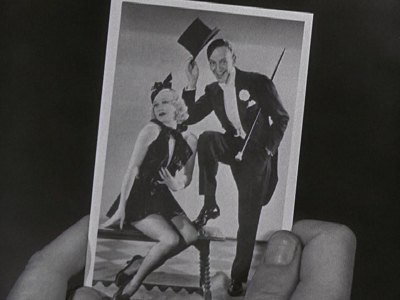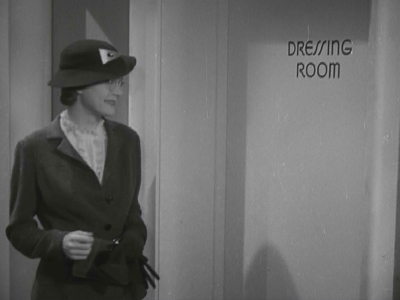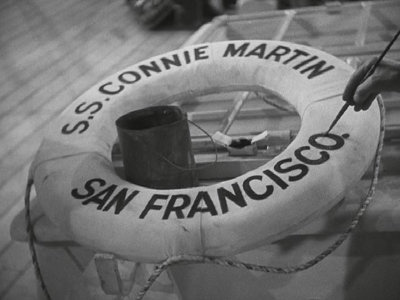 BUY IT AT AMAZON:
BUY IT AT AMAZON:
CLICK HERE!
STUDIO: Warner Bros.
MSRP:
$19.97
RATED: NR
RUNNING TIME: 110 Minutes
SPECIAL
FEATURES:
• New Featurette: Follow the Fleet: The Origins of Those Dancing Feet
• Musical short: Melody Master: Jimmy Lunceford and His Dance Orchestra
• Classic Cartoon: Let It Be Me
• Original Theatrical Trailer
The first
thing that I noticed about the cover to this DVD was that Irving Berlin gets
billing above director Mark Sandrich (who also directed Astaire and Rogers in Top
Hat, The Gay Divorcee, and others); not only that, but Berlin’s name
is several orders of magnitude larger than Sandrich’s, and it has that nifty
enlarging of the surname, just like stars Fred Astaire and Ginger Rogers. It
wasn’t an uncommon practice in the thirties for directors to get the proverbial
shaft on the recognition front (this was well before the auteur movement), but it does cast an interesting light on the film
itself, in which the amount of work evident in the direction is much lower than
that of the song and dance routines.
This is a
Fred and Ginger movie, so it’s Fred and Ginger that the audience wants, not
directorial flair. For this reviewer, though, the sloppy blocking and pacing of
the plot sequences detracted quite a bit from the enjoyment of the film.

Fred & Ginger, 1UW; Creature – Superhuman;
U, TAP: Your pimply opponent makes fun of you for enjoying classic films.
The Flick
Follow the Fleet was Fred and Ginger’s fifth of ten
movies together, and most people rate it toward the bottom of the list. (It was
followed by the wonderful Swing Time, the DVD of which our
Newell reviewed right here.) There’s not a whole lot of fleet following going
on, but it is about the Navy. Astaire plays seaman "Bake" Baker, a
cocky and talented bandsman aboard an unnamed battleship. His ship comes to
harbor in
head straight for the waiting girls, Bake just wants to renew his relationship
with his old stage partner, Sherry (Ginger Rogers).
The
problem is that Bake and Sherry didn’t exactly part on good terms. Bake had
asked her to marry him, she refused, and he joined the Navy to escape her. Now,
without him, her career is in shambles. When they reunite in
that the only way she’ll succeed on stage is with him as a partner. However,
not being a complete narcissist, he promises to help her get an audition the
following day with a prominent show owner that he knows.
During
the night, the fleet sails off again.
This is a
good point to mention two small quibbles with the progression of the story.
First, the editing gives us no clear indication of the passage of time in
between sequences. The fleet sails away, we have some interstitial scenes with
Sherry and her sister Connie (Harriet Nelson nee Hilliard, Ozzie and Harriet), and
then the fleet returns. There were no title cards to explain it, but apparently
quite some time passes over the fleet’s departure and its arrival.

"Oh! I love the dreffing room!"
Second, I
was somewhat thrown by the heavy women’s empowerment theme that seemed to be
growing from all of Bake’s condescension (and also the masculine posturing of
Bilge Smith, provided by Randolph Scott in a supporting role as Bake’s shipmate
who sort of falls for Sherry’s sister). The writer laid it on thick during this
first sequence after the fleet comes to port, and then, after that, further
exploration of the theme is left to standard lovers’ spats which don’t serve to
broaden the discussion. Either I missed out on some incredible subtlety, or the
whole idea was scrapped. Either way, it puts a bitter spin on the standard love
story that dominates the remainder of the film.
The rest
of the running time is divided about equally between Fred and Ginger delivering
lines hesitantly and performing their dance sequences with typical aplomb. The
plot becomes weaker as it progresses, devolving into a set of far-fetched
schemes by one or the other of our favorite couple, either for revenge or for
success. As this is going on, the subplot between Connie and Bilge provides an
out for the plot as it turns toward the elaborate staging of a musical to raise
money so Connie can keep her own ship, which she purchased for Bilge so that he
could be his own captain.
In the
end, Bilge and Connie get together, and one plot thread is wrapped up too
neatly; Bake and Sherry resolve their differences, but the end is saved from
the Shakespearian "everyone get married" comedic conclusion by Bake
being carted off to the brig for assaulting a superior officer.

Stereotypes have to exist somewhere, right?
Otherwise, they wouldn’t be stereotypes.
So, the
plot ain’t that great, and it unrolls in fits and starts, but the work of
Irving Berlin is a sheer delight to watch. Follow the Fleet features such
classics as "Let’s Face The Music And Dance" and "I’m Putting
All My Eggs In One Basket", and they’re staged just about perfectly. There
are few cuts during these sequences, and very little motion of the camera, so
there’s no interference by way of the direction. Astaire and Rogers get to show
what wonderful range their bodies have, dancing a delicate ballroom, a
slapstick routine, dancing, and the speediest tap this side of the
in timing (except for one tiny part in "Let’s Face The Music" when
Ginger hits Fred in the face with the sleeve of her dress). They move so well
together that even the more allegro
numbers have a gentleness about them as each of the leads settles into the
movements of the other.
The
uneven, familiar plot and poorly-rehearsed dialogue sequences add a note of
roughness to the picture, but Follow the Fleet is far from a bore
or a struggle to get through. Those with top billing put in fine and
entertaining work all around; it’s just the director that seems to have had a
few problems.
8 out of 10
The Look
Beautiful
black-and-white (BBW?) in its original full frame presentation. I would have
rated this a bit higher if the shots had had more variety in contrast, but too often
the sets are flooded with one end of the spectrum or the other. Though the
balance is off, the actual blacks and whites themselves are weighted perfectly.
Just look at those cute little sailor suits! The amount of grain left over from the print
is acceptable, hedging toward distracting for the exteriors.
7 out of 10

San Francisco is not a complete sentence.
The Noise
The music
and singing come through just great, with nary a swallowed tone in earshot.
It’s in Dolby Digital Mono, so you can forget about filling your house with
faceless music and dancing. In dialogue sequences, there is occasionally some
trouble with sibilance causing crackles and hisses in the soundtrack. They’re
quick blemishes, though, and not too frequent, so they’re not hard to live
with.
6 out of 10
The Goodies
There’s a
featurette called "Follow the Fleet: The Origins of Those Dancing
Feet" which puts Follow the Fleet into a biographical
context for its stars and a historical context for its position in the ten film
career of the team-up. It’s comprised mainly of interviews with family members,
film historians, and biographers, and runs about fourteen minutes. There’s some
good, film-specific information in there and it’s worth a gander.
The
second featurette is a vintage short musical called "Jamie Lunceford and
His Dance Orchestra". It’s a filmed stage performance by a black,
jazz-influenced big band. It feels somewhat out of place as a separate feature
from the film, rather than playing in front of it, but it’s a great tune with
some fine musicianship.

Fred and Ginger’s love-child was set for a successful showbiz career from day one.
Not
counting the theatrical trailer, the last extra is a Warner Brothers Merrie
Melody cartoon short that, like the above concert performance, is that sort
that would play before the flick in the cinema. It doesn’t add much, but it’s a
nice touch to have been included on the disc.
7 out of 10
The Artwork
In the
tradition of these DVD releases, the original theatrical poster is used as
cover art. This one is colorful and laid out perfectly. The look on Astaire’s
face seems to have him fantasizing about, plotting for, and regretting all at
once the coquettish
7.5 out of 10